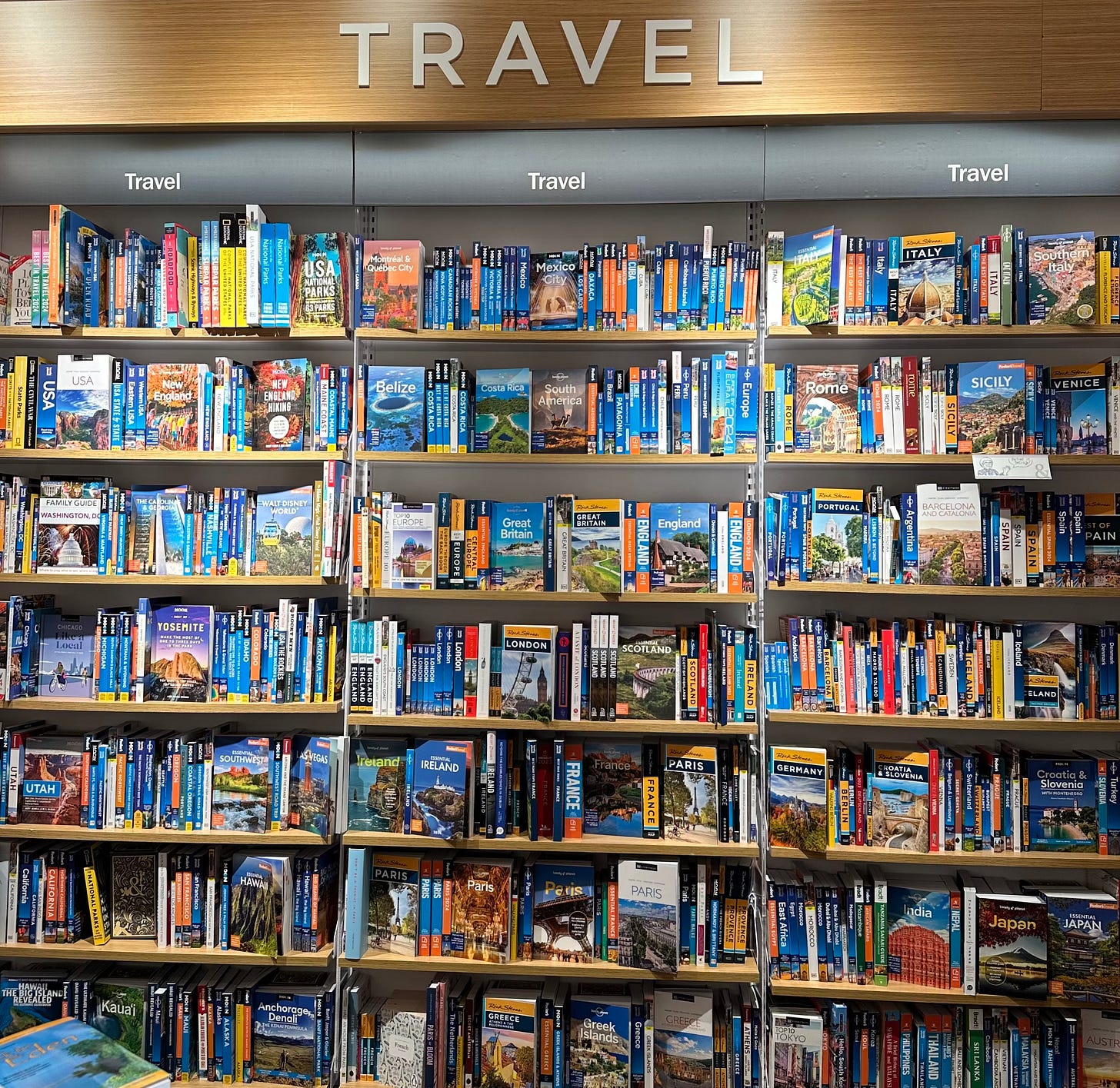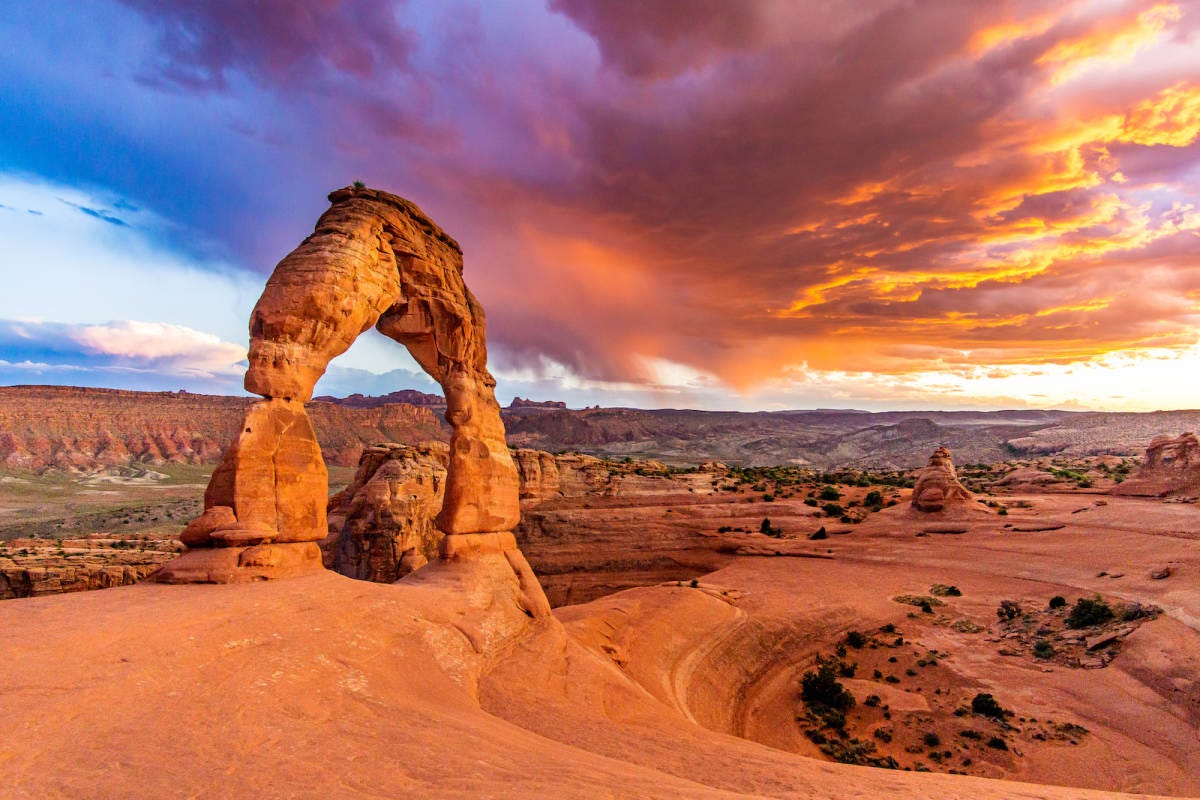A couple of amazing things happened today.
The first was that I walked into a bookstore—a physical store that sells paper books—in my New York neighborhood. This wasn’t some chicly curated shop for the literati or a musty antique reading room with yellowing tomes. This was a brightly lit, new-smelling bookstore. The kind you’d find in the 1990s along a major highway or in a mall.
And just as I remembered from those years, there were wide yawning aisles and huge signage to direct shoppers (nay, readers!) towards their literary desires: FICTION, COOKBOOKS, CHILDREN’S. As if on cue, No Doubt’s 2001 hit “Hey Baby” played through the overhead speakers.
There were some markers of modern cultural relevance and evolution: MENTAL HEALTH, BLACK INTEREST, IF YOU LIKE ROM-COMS. But it took more than 20 minutes of wandering (and a surfeit of pride not to inquire with any of the employees) to find the section called TRAVEL.
Maybe the trek was meant to be ironic. I circled around and around corners of novelty journals, coffee table books about brownstones and the Bauhaus, classics by Poe and Plath. It was work to finally arrive at the travel section, which was stuffed into the store’s furthest corner. How could this have happened? (I knew our society was teetering on the edge of collapse. Now this?!)
But that’s when the second amazing thing happened. I decided to buy a guidebook.
I’d gone to the store to find quality travel literature by Pico Iyer or Paul Theroux. Instead, I was met with a single wall of guidebooks. (You know, those big paper things you used to stuff into your backpack, along with a No Doubt CD.)
While most of these antiquated specimens were arranged with their bright blue spines with white lettering facing out, one guidebook’s bold orange cover faced me head-on: Arches & Canyonlands National Parks. Kismet. That’s where I’ll be in a few weeks, and this sucker was coming along for the ride.
Back home, I cracked open the cover to find two author photos. In our Instagram-ified era of travel research (“research” might be too generous a word) most travel experts (“experts” might be too generous a word) are svelte twenty-somethings, miraculously outfitted in a Versace gown in a suspiciously empty Tokyo street at noon. #TravelHackYouGuys!
But here on the opening pages of Arches & Canyonlands National Parks were authors Judy Jewell and W.C. “Bill” McCrae, a pair of white-haired Boomers who probably haven’t traversed much further across the World Wide Web than Bing or Facebook. And you know what? I immediately trusted them. Unlike those dewy-faced vegans who infest my Instagram feed, Judy and Bill seemed to know what’s up.
Judy’s author headshot looks out with a gummy smile. She dons a light blue button-down with an appliqué on the left shoulder, the design echoing the contours of a petroglyph. Meanwhile, Bill, in his smart black-rimmed spectacles, has been “exploring Utah for decades”—longer than many of my influencers have been alive—and looks like he’d get into a pointed argument about the best slot canyon east of the Colorado River. These were my people.
In the years since I purchased such a guidebook, I’d forgotten how comprehensive they are. There’s always a history of the area; a series of detailed maps; outfitter phone numbers; linguistic glossaries; tips to avoid hypothermia or Giardia; guides to local customs and tipping; and photos that just sit there on the page and don’t move or flash or implore you to keep scrolling.
This particular guidebook even offered a dash of salacious prose as early as page 12:
“Expansive vistas take in hundreds of miles of canyon country, while rafting the Colorado’s Cataract Canyon is the wet and thrilling climax of many a vacation.”
Judy! Bill! I’m blushing!
The last time I’d actually depended on a guidebook while traveling was when my college roommate and I prepped for a post-grad trek from New Jersey to San Diego. We drove to a bookstore and purchased the 448-page paperback Hostels U.S.A. It had a garish cover design of red, white and blue text set around cutout photos of two floating thumbs respectively pointing up and down (a predecessor to the emojis we have today) to indicate the promised “at-a-glance rating” of all 300 hostels contained within its pages.
We spent days and nights pouring over the book, highlighting and dog-earing pages of dwellings that promised to be just cheap enough for us to afford but not be murdered in our sleep.
We printed out Mapquest directions for the many legs of this 2,738-mile drive. These, too, would be guarded with our lives, as would the proudly ‘merican hostel Bible. Without these in tow, we’d have just rolled hopelessly from town to town in our manual Chevy pickup with little more than our charm.
That was half a lifetime ago, and when my husband and I go to Utah in June, I know we’ll be checking our iPhones every three seconds or so. Admittedly, my spiffy new Arches guidebook, for all of its anachronistic charms, isn’t all that new. Published in 2021, it was likely researched in 2020, the time of a pesky pandemic. The resort where we’ll be staying wasn’t even built until the spring of 2022. Surely some of the bars and restaurants have closed. There will be real-time updates that we’ll need about trail conditions and weather forecasts. Someone probably will post a useful tidbit on social media while we’re in the desert.
But I’m keeping Bill and Judy close by (and not just for all the sex talk about rock formations.) We miss too much in our frenetic digital world of travel posts and alerts and apps. This duo has poured a lifetime of Western know-how into writing a physical book, and that gives me confidence that no Instagram reel or pithy listicle can. I guess Gwen Stefani was right in “Hey Baby” when she sang, “No matter what they say I'm still the same.”








